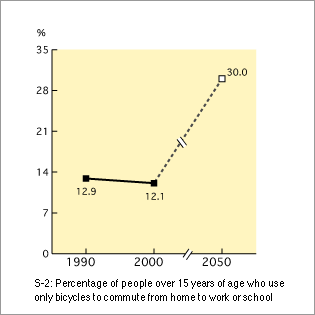ProjectsPast and current JFS projects
Indicators - Society / Mobility
S-2. Percentage of people over 15 years of age who use only bicycles to commute from their home to work or school
1.Current Values12.1% (2000)
2.Current Points
(out of a perfect score of 100 by 2050) 40 points
Calculation method:
(Current value - minimum value) / (2050 target value - minimum value) x 100
3. Explanation of Indicator
The Sustainable Mobility Project (SMP) of the WBCSD defines mobility as "the ability to meet the needs of society to move freely, gain access, communicate, trade, and establish relationships without sacrificing other essential human or ecological values today or in the future."
SMP cites multiple target areas from aspects including environment ("conventional" emissions, greenhouse gas emissions) and safety, noise and traffic congestion, and access. In view of this, JFS thinks that it is very important to shrewdly use a variety of mobility methods in response to different needs for movement. We are focusing on the sort of commuting that is relevant and most familiar to anyone. One can say that commuting with a bicycle, rather than relying on advanced transportation technology, is desirable not only from the environmental point of view, but also from that of safety and easing of traffic congestion.
Related information:
WBCSD Sustainable Mobility
4.Target for 2050
30%
5.Ideal for the Future
30%
6. Rationale for Ideal and Target Values
Because the amount of bicycle use depends upon such things as geography, population density and the stage of economic development, we referred to examples of cities with conditions akin to those of Japanese cities, cities in advanced nations with high population densities.
According to a 2002 survey conducted by Prof. John Pucher of Rutgers University in the United States, bicycle use in Holland accounts for 30% of all transportation means. Also, in Copenhagen, Denmark, one-third of the population commutes to work on bicycles. For the sake of argument, we have set 30% as both our ideal and our target level for 2050, matching the levels in these bicycle-using countries.
It would also be good to have data that included not just bicycle commuting, but commuting on foot and by public transport as well. Speaking from the viewpoint of not only the environment but also health and easing of congestion, the Japanese Learned Society for a Bicycle Society has proposed in its "25-25 plan", that walking, bicycles, and public transport should each be at 25% by the year 2050
7. Source
8. Notes
*WBCSD: World Business Council for Sustainable Development



